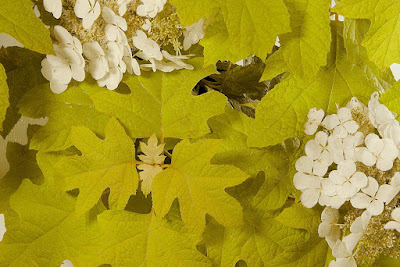Hydrangea quercifolia Little Honey - Little Honey hydrangea have golden-chartreuse foliage in summer that turns scarlet in fall, and red stem color.
Hydrangea quercifolia Little Honey also called as Little Honey hydrangea, is a cultivar in the genus Hydrangea. This cultivar was discovered by David Jarzynka in 1999 in a cultivated area of Olympia, Wash.
DESCRIPTION OF HYDRANGEA QUERCIFOLIA LITTLE HONEY - LITTLE HONEY HYDRANGEA
Hydrangea quercifolia Little Honey is an individual branch sport of the parent plant Hydrangea quercifolia ‘Pee Wee’. The characteristics of the plant have been determined stable and are reproduced true to type in successive generations.
It is a dwarf perennial shrub which reaching 63 cm tall by 63 cm spread with compact, upright and spreading habit. The plant sprouts shoots from underground stolons and often grows in colonies. The leaves are deciduous, opposite, palmate to ovate, serrate margin, acute base, cuneate base, 9-16 cm long by 10-18 cm wide, golden chartreuse and turn dark scarlet in fall with red stems in winter.
Little Honey hydrangea blooms in summer on the conical shaped, 22-23 cm long by 9-12 cm in diameter panicles with about 60-100 flowers per panicle. The white flowers last from 2-4 weeks on individual panicles. Unlike bigleaf hydrangea (Hydrangea macrophylla), flower color does not vary with soil pH.
HYDRANGEA QUERCIFOLIA LITTLE HONEY - LITTLE HONEY HYDRANGEA CARE AND CULTURE
Cultural information should only be used as a guide, and should be to be adapted to suit you. Your physical location; where you grow your plants, how much time you have to devote to their care, and many other factors, will need to be taken into account. Only then can you decide on the cultural methods that best suit you and your plants.
Light:
Hydrangea quercifolia Little Honey love the warm morning sun, but they dislike the heat of the afternoon. The best place for the plant is in a sheltered location with sunny mornings and shady afternoons. Avoid planting directly underneath trees, which can lead to competition for water and nutrients. High winds can rip and damage leaves and destroy the flowers. Although they can be successfully grown in full shade, they will not bloom well.
Temperature:
Little Honey hydrangea prefers a cool location, from 18° to 24°C. The plant may suffer from considerable branch dieback during the cold months and will benefit from winter protection. Winter protection can be provided by constructing a wire framework around the plant and filling the space with shredded leaves to a depth of approximately 10-12” for insulation. Cold winters and late spring frosts can often kill flower buds, preventing plants from blooming in the spring. When unexpected cold weather is predicted in late spring or early summer after winter protection has been removed, it may be necessary to cover tender plant with cloth, burlap, or heavy paper to protect flower buds. Plastic should never be used as winter protection because it may damage tender plant tissue.
Substrate, growing media:
Hydrangea quercifolia Little Honey are best planted in well-drained, moist soil, preferably a fertile sandy or silt loam with greater than 1% organic matter. The plant can also grow in clay soils with proper water management. When grown in container, the plant needs a well-drained substrate with sphagnum peat moss to increase substrate water holding capacity, and perlite or pumice to maintain adequate air space.
Humidity and Watering:
Little Honey hydrangea prefers consistent moisture but dislike wet feet. The plant should be watered thoroughly at least 3 times a week. Always water the plant all the way around the container, not just in one place. Water should come out the bottom of the pot. Never let it sit in water which will cause the roots to rot away. Mulch to help conserve moisture and cool the root system. A two- to three-inch layer of mulch will help to conserve moisture.
Fertilizer:
Fertilizing is generally not recommended unless a nutrient deficiency is observed. The plants may need little fertilizer in rich soil with organic matter applied yearly. Avoid using too much nitrogen, too much nitrogen can produce excessive green growth at the expense of flowers. If you do fertilize, do a little research to find out exactly what your plant might need, and always apply as directed and read and follow all label directions.
Pruning:
The plant blooms on the previous year’s branches or old wood, minimal pruning is recommended. Prune to remove deadwood anytime and consider removing old flower heads soon after blooming. Reshape malformed plants in late winter by cutting them back to just above the pairs of buds on each stem, and/or remove the largest canes all the way to the ground.
Propagation:
Hydrangea quercifolia Little Honey is mainly propagated by softwood cuttings. The cutting should be taken from non-flowering green woody stems and cut at the base. Each cutting should have at least one leaf node or terminal bud. It is important not to damage the buds while obtaining the cuttings. Dip your cutting into your rooting hormone, then place into the sterile media that should consist of one part peat and one part medium to fine grade perlite, vermiculite, or sand. Spray the plant until wet but dont over water it. Watering is important for the first week, three times a day is recommended for the first week when top soil feels dry. Dont place the plant in direct sunlight or wind. After a few weeks you should see growth from your cuttings.
Pests and diseases:
Little Honey hydrangea are almost trouble-free. However, certain pests and diseases can attack. The most common time for them to do so is in the summer months. They most commonly suffer from powdery mildew, aphids, spider mites, yellow leaves and leaf spots. All of these are common to spot and treat, providing you catch the disease or pest early.















COMMENTS